Diana
RSP 10235
Grower: CSU
General Information
- Sample Name
- Diana-1
- Accession Date
- May 12, 2016
- Reported Plant Sex
- Female
- Report Type
- StrainSEEK v2 3.2Mb
- DNA Extracted From
- Leaf
The strain rarity visualization shows how distant the strain is from the other cultivars in the Kannapedia database. The y-axis represents genetic distance, getting farther as you go up. The width of the visualization at any position along the y-axis shows how many strains there are in the database at that genetic distance. So, a common strain will have a more bottom-heavy shape, while uncommon and rare cultivars will have a visualization that is generally shifted towards the top.
Chemical Information
Cannabinoid and terpenoid information provided by the grower.
Cannabinoids
No information provided.
Terpenoids
No information provided.
Genetic Information
- Plant Type
- Type II
File Downloads
The bell curve in the heterozygosity visualization shows the distribution of heterozygosity levels for cannabis cultivars in the Kannapedia database. The green line shows where this particular strain fits within the distribution. Heterozygosity is associated with heterosis (aka hybrid vigor) but also leads to the production of more variable offspring. When plants have two genetically different parents, heterozygosity levels will be higher than if it has been inbred or backcrossed repeatedly.
The ratio of reads mapped to Y-contigs to reads mapped to the whole Cannabis genome (Y-ratios) has been demonstrated to be strongly correlated with plant sex typing. This plot shows the distribution of Y-ratios for all samples in our database which were sequenced with the same method (panel or WGS) as this sample and where this sample falls in the distribution.
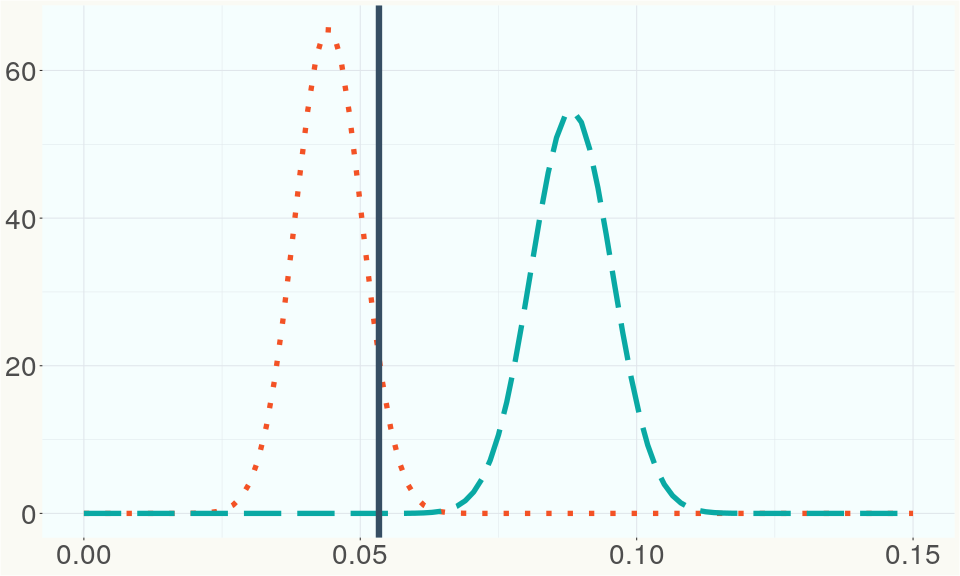
This chart represents the Illumina sequence coverage over the Bt/Bd allele. These are the three regions in the cannabis genome that impact THCA, CBDA, CBGA production. Coverage over the Active CBDAS gene is highly correlated with Type II and Type III plants as described by Etienne de Meijer. Coverage over the THCA gene is highly correlated with Type I and Type II plants but is anti-correlated with Type III plants. Type I plants require coverage over the inactive CBDA loci and no coverage over the Active CBDA gene. Lack of coverage over the Active CBDA and Active THCA allele are presumed to be Type IV plants (CBGA dominant). While deletions of entire THCAS and CBDAS genes are the most common Bt:Bd alleles observed, it is possible to have plants with these genes where functional expression of the enzyme is disrupted by deactivating point mutations (Kojoma et al. 2006).
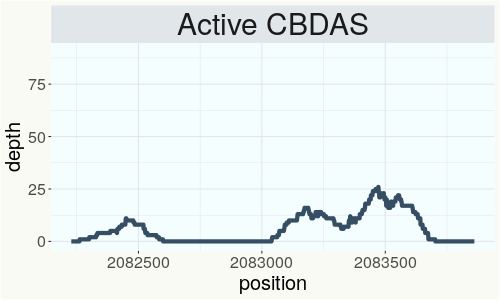
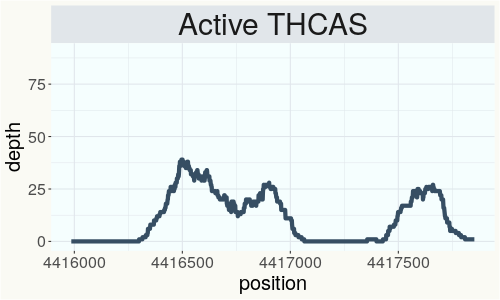
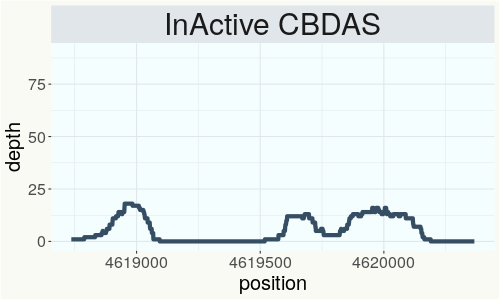
This chart represents the Illumina sequence coverage over the CBCA synthase gene.
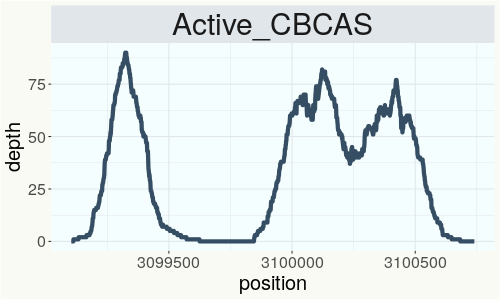
Variants (THCAS, CBDAS, and CBCAS)
No variants to report
Variants (Select Genes of Interest)
| PKSG-2a | c.67T>A | p.Phe23Ile | missense variant | moderate | contig700 | 1945567 | A/T | |
| PKSG-2a | c.31A>T | p.Thr11Ser | missense variant | moderate | contig700 | 1945603 | T/A | |
| PKSG-2b | c.948T>G | p.Asp316Glu | missense variant | moderate | contig700 | 1950690 | A/C |
|
| PKSG-2b | c.945T>G | p.Ser315Arg | missense variant | moderate | contig700 | 1950693 | A/C |
|
| PKSG-2b | c.944G>A | p.Ser315Asn | missense variant | moderate | contig700 | 1950694 | C/T |
|
| PKSG-2b |
c.938_939ins |
p.Ser315fs | frameshift variant | high | contig700 | 1950699 | T/TC |
|
| PKSG-2b | c.934C>G | p.His312Asp | missense variant | moderate | contig700 | 1950704 | G/C |
|
| PKSG-2b | c.31A>T | p.Thr11Ser | missense variant | moderate | contig700 | 1951851 | T/A | |
| PKSG-4b | c.496A>G | p.Lys166Glu | missense variant | moderate | contig700 | 2721177 | T/C | |
| PKSG-4b | c.489delT | p.Phe163fs | frameshift variant | high | contig700 | 2721183 | CA/C | |
| PKSG-4b | c.485A>G | p.Lys162Arg | missense variant | moderate | contig700 | 2721188 | T/C | |
| PKSG-4b | c.431T>G | p.Val144Gly | missense variant | moderate | contig700 | 2721242 | A/C | |
| aPT4 | c.470T>C | p.Leu157Ser | missense variant | moderate | contig121 | 2830665 | T/C |
|
| aPT4 | c.517A>T | p.Ile173Leu | missense variant & splice region variant | moderate | contig121 | 2830795 | A/T |
|
| aPT4 | c.634C>A | p.Pro212Thr | missense variant | moderate | contig121 | 2830912 | C/A |
|
| aPT4 | c.757G>T | p.Val253Leu | missense variant | moderate | contig121 | 2831364 | G/T |
|
| aPT4 | c.1156A>T | p.Met386Leu | missense variant | moderate | contig121 | 2833491 | A/T |
|
| aPT4 | c.1168T>C | p.Tyr390His | missense variant | moderate | contig121 | 2833503 | T/C |
|
| aPT1 |
c.95_97delGT |
p.Cys32del | disruptive inframe deletion | moderate | contig121 | 2835800 | ATGT/A | |
| aPT1 | c.406A>G | p.Ile136Val | missense variant | moderate | contig121 | 2839605 | A/G | |
| aPT1 | c.629C>T | p.Thr210Ile | missense variant | moderate | contig121 | 2840237 | C/T | |
| aPT1 | c.715G>C | p.Ala239Pro | missense variant | moderate | contig121 | 2841350 | G/C |
|
| aPT1 | c.727G>T | p.Glu243* | stop gained | high | contig121 | 2841362 | G/T | |
| aPT1 | c.958G>A | p.Gly320Ser | missense variant | moderate | contig121 | 2842731 | G/A |
|
| HDS-2 |
c.82_93delGT |
p.Val28_Thr3 |
conservative inframe deletion | moderate | contig95 | 1989748 |
CGTAACCGGAAC |
|
| HDS-2 | c.127T>G | p.Ser43Ala | missense variant | moderate | contig95 | 1989794 | T/G |
|
Nearest genetic relatives (All Samples)
- 0.188 USO 31 (RSP10983)
- 0.189 Santhica 27 (RSP10665)
- 0.194 USO 31 (RSP10981)
- 0.195 Lovrin (RSP10658)
- 0.195 Santhica27 (RSP10056)
- 0.203 Carmagnola USO 31 (RSP11204)
- 0.205 Bialobrzeskie (SRR14708244)
- 0.206 Ivory (RSP10668)
- 0.206 Fedora 17 (SRR14708222)
- 0.206 Santhica27 (RSP11046)
- 0.208 Uniko B (SRR14708278)
- 0.209 Beniko (SRR14708275)
- 0.210 Santhica27 (RSP11047)
- 0.210 Chamaeleon (SRR14708197)
- 0.212 Ferimon 12 (SRR14708233)
- 0.213 Tisza (RSP10659)
- 0.214 Futura 75 (RSP10664)
- 0.214 USO31 (RSP10233)
- 0.214 Kompolti (SRR14708277)
- 0.216 Tisza (RSP11045)
Most genetically distant strains (All Samples)
- 0.453 Cherry Blossom (RSP11312)
- 0.435 Cherry Blossom (RSP11311)
- 0.433 Cherry Blossom (RSP11323)
- 0.433 Cherry Blossom (RSP11298)
- 0.431 Cherry Blossom (RSP11318)
- 0.428 Cherry Blossom (RSP11300)
- 0.427 QQD2 (RSP11450)
- 0.425 Cherry Blossom (RSP11301)
- 0.421 Cherry Blossom (RSP11331)
- 0.418 Chem 91 (RSP11185)
- 0.414 New York City Deisel (RSP11225)
- 0.412 Cherry Blossom (RSP11328)
- 0.411 Up Sunset (RSP11256)
- 0.410 CHEM4 (RSP12090)
- 0.409 QLE1 (RSP11451)
- 0.409 Cherry Blossom (RSP11319)
- 0.408 Cherry Blossom (RSP11309)
- 0.408 Unknown--Cherry Wine---001- (RSP11268)
- 0.407 Chematonic -Cannatonic x Chemdawg- (RSP11394)
- 0.407 Escape Velocity (RSP11165)
Nearest genetic relative in Phylos dataset
- Overlapping SNPs:
- 118
- Concordance:
- 78
Nearest genetic relative in Lynch dataset
- Overlapping SNPs:
- 4
- Concordance:
- 3
Blockchain Registration Information
- Transaction ID
-
f2295c13f06f86a3
e6c567b05c12d678 098b5492cd8fe6a7 f651df05ce91b1d5 - Stamping Certificate
- Download PDF (858.8 KB)
- SHASUM Hash
-
9d2c031be1c221457af01243d7e392be 6b6af8c7cf0f8457 36330768df0263df